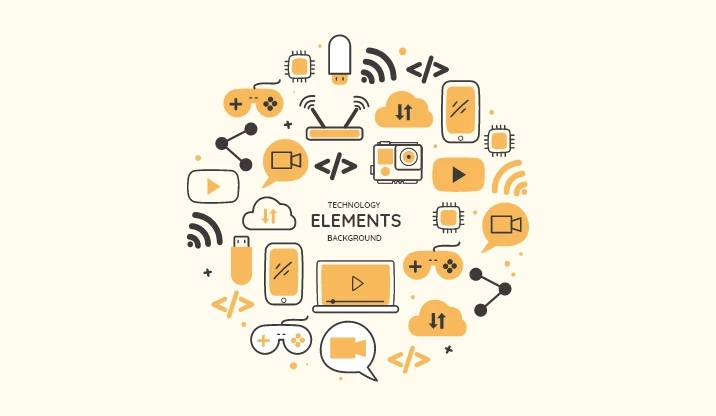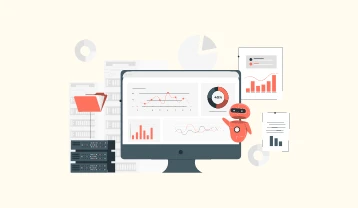Overview of IoT based projects for ECE
IoT projects for ECE (Electronics and Communication Engineering) can involve designing and implementing electronic systems that are connected to the internet and can communicate with other devices. Some popular IoT based projects for ECE students or iot project ideas for ece students include IOT-based smart home automation, IOT health monitoring systems, Smart agriculture, IIOT, and Industrial Automation.
Top 20 IOT Project Ideas and topics for ECE Students
Here are some of the Top IoT Based Project Ideas For ECE Students
1. Advanced IOT Home Automation Using Google Assistant and ThingSpeak IOT Platform
This project aims to develop an advanced IoT-based home automation system using Google Assistant and the ThingSpeak IoT platform. The system allows users to control their home devices such as lights, fans, and air conditioning using voice commands through Google Assistant. The ThingSpeak platform is used to receive and process the data from the IoT devices and trigger the appropriate actions.
Two use cases of this project are:
1) Turning on/off lights and fans using voice commands via Google Assistant.
2) Automatically adjusting the temperature of the air conditioning system based on the temperature and humidity levels sensed by IoT sensors.
2.IoT Based project- Web Controlled Multiple Home Automation and Monitoring with Raspberry Pi
This project aims to develop an IoT-based web-controlled home automation and monitoring system using a Raspberry Pi board. The system allows users to control and monitor various devices in their home, such as lights, fans, and security cameras, using a web interface from anywhere in the world. The Raspberry Pi board acts as a central hub that communicates with the IoT devices and the web interface.
The system uses various sensors and actuators to control the devices and monitor the home environment. For example, temperature sensors can be used to control the air conditioning system, while motion sensors can trigger the security cameras. The system also includes a web camera that allows users to monitor their home remotely.
Advantages:
1) Convenience: The web-based interface allows users to control their home devices from anywhere in the world, providing convenience and flexibility.
2) Energy Efficiency: The use of sensors and actuators can help to optimize energy consumption by turning off devices when not in use.
3) Increased Security: The system includes security cameras and motion sensors, providing increased security and peace of mind for homeowners.
4) Easy to Use: The web interface is easy to use and can be accessed from any device with an internet connection.
5) Cost-Effective: The system uses off-the-shelf components such as the Raspberry Pi board, making it a cost-effective solution for home automation and monitoring.
Overall, this IoT-based home automation and monitoring system can provide users with greater convenience, energy efficiency, and security. With the increasing popularity of IoT devices and the growth of the smart home market, this project has significant potential for practical applications in the home automation industry.
3.IOT based -Electric Vehicle Lithium-ion Battery Ageing Analysis under Dynamic Condition: A Machine Learning Approach.
Abstract:
This project aims to develop a machine learning-based approach for analyzing the aging behaviour of lithium-ion batteries used in electric vehicles under dynamic conditions. The proposed approach considers various dynamic factors such as vehicle speed, temperature, and driving patterns that affect the aging of the battery. The machine learning model is trained on data collected from various test scenarios and is capable of predicting the remaining useful life (RUL) of the battery under different dynamic conditions.
Two use cases of this project are:
1) Predicting battery life: The machine learning model can predict the RUL of the battery based on dynamic factors such as vehicle speed, temperature, and driving patterns. This information can be used by the vehicle owner to plan battery replacement and maintenance.
2) Optimizing battery usage: By analyzing the ageing behavior of the battery, the machine learning model can provide recommendations for optimizing battery usage, such as charging and discharging strategies and driving patterns.
Advantages:
1) Accurate analysis: The machine learning approach considers various dynamic factors that affect the aging behavior of the battery, providing a more accurate analysis of the battery’s RUL.
2) Cost-effective: By predicting the RUL of the battery, the approach can help in optimizing battery usage, reducing the need for frequent replacements and saving costs.
3) Efficient maintenance and Improved battery performance
4. IoT-based Battery Management System for E-Vehicles
Abstract:
In today’s modern world electric vehicles are in trend for transportation purposes and it replaces traditional transportation, by making a pollution-free environment. In electric vehicles, different types of batteries like Lithium batteries, Lead-acid batteries, Nickel-Metal batteries, and Solid-state batteries are used. Of these types of batteries, the most preferable is the Lithium battery. Because of its high energy per unit mass and most efficient than other batteries and it can be recycled.
In this study, a battery management system is proposed using the Internet of Things. This system comprises of sensors like temperature, voltage, and current which send the signal to the microcontroller and send the data to the cloud-like ThingSpeak. When the data goes to a high level, the alert mail will be sent by ThingSpeak and the place can be located by using the Global Positioning System. The perspective of this paper is to maintain the batteries in the electric vehicle to alert about the performance of the battery.
5.IoT-based Battery Management System by Deploying an Machine Learning Model
Abstract:
The IoT-based Battery Management System (BMS) is a project that involves the development of a smart battery management system that uses IoT sensors and machine learning algorithms to optimize the performance and lifespan of batteries. The system is designed to monitor battery health, predict battery life, and provide real-time alerts when the battery is running low or needs maintenance.
The BMS uses IoT sensors to collect data on battery temperature, voltage, and current, and sends this data to a cloud-based platform for analysis. Machine learning algorithms are then used to process this data and generate insights on battery performance, including predictions on battery life and recommendations for optimizing battery usage.
The advantages of this project include:
1) Improved Battery Performance: The BMS can help to optimize battery performance by providing real-time insights on battery health and usage, allowing users to take proactive measures to extend battery life and improve performance.
2) Predictive Maintenance: The BMS can predict when a battery is likely to fail, allowing for timely maintenance or replacement before a critical failure occurs.
3) Cost Savings: By optimizing battery usage, the BMS can help to reduce battery replacement costs, extend battery life, and reduce downtime due to battery failure.
4) Enhanced Safety: The BMS can help to prevent battery failure and potential safety hazards, by alerting users when the battery is running low or requires maintenance.
Overall, the IoT-based Battery Management System is an innovative and practical application of IoT and machine learning technologies, which can improve the performance, safety, and lifespan of batteries in a range of applications, including electric vehicles, renewable energy systems, and portable devices.
6.AI and IoT-based Electric Vehicle Monitoring System
Abstract:
The AI and IoT-based Electric Vehicle (EV) Monitoring System is a project that involves the development of a smart monitoring system that uses IoT sensors and artificial intelligence algorithms to optimize the performance, safety, and efficiency of electric vehicles. The system is designed to monitor various parameters of the EV, such as battery health, charging status, and vehicle location, and provide real-time insights to drivers, fleet managers, and service technicians.
The EV Monitoring System uses IoT sensors to collect data on various parameters of the EV, including battery temperature, voltage, and current, as well as the charging status and location of the vehicle. This data is then sent to a cloud-based platform for analysis using AI algorithms, which can generate insights on battery health, charging patterns, and vehicle usage.
Use Cases:
Fleet Management: The EV Monitoring System can be used by fleet managers to monitor the performance and usage of their electric vehicles. This can include tracking vehicle location and charging status, as well as monitoring battery health and predicting maintenance requirements. This can help fleet managers to optimize vehicle usage and reduce maintenance costs.
1) Driver Monitoring: The EV Monitoring System can be used by individual drivers to monitor the performance of their EV, including battery health and charging patterns. This can help drivers to optimize their driving habits and extend the range of their EV.
2) Service Technicians: The EV Monitoring System can be used by service technicians to monitor the health of the EV battery and other components, and to diagnose any potential issues before they become critical. This can help to reduce downtime and repair costs, and ensure the safety and reliability of the EV.
Overall, the AI and IoT-based Electric Vehicle Monitoring System is an innovative and practical application of IoT and AI technologies, which can improve the performance, safety, and efficiency of electric vehicles. This project has applications in a range of industries, including transportation, logistics, and automotive manufacturing.
7.Smart Farming based on AI, Edge Computing and IoT
Abstract:
Smart farming based on AI, edge computing, and IoT is an innovative solution to address the challenges in the agriculture industry. The system employs AI algorithms, edge computing devices, and IoT sensors to gather data from the farming environment and provide real-time insights to farmers. The system enables farmers to optimize their operations, increase productivity, reduce costs, and minimize the environmental impact of their farming activities.
The smart farming system consists of edge computing devices, sensors, and actuators that are deployed across the farm. The sensors collect data on various parameters such as soil moisture, temperature, and nutrient levels, while the actuators control irrigation, fertilization, and other farming operations. The data collected by the sensors is sent to an AI-powered platform that uses machine learning algorithms to generate insights on crop health, soil quality, and other factors affecting crop growth.
Advantages:
1) Improved Productivity: Smart farming systems can help farmers to increase their productivity by optimizing farming operations. By using real-time data on crop health, weather conditions, and soil quality, farmers can make informed decisions on irrigation, fertilization, and other farming activities.
2) Reduced Costs: Smart farming systems can help farmers to reduce costs by minimizing the use of resources such as water and fertilizer. By using data on soil moisture and nutrient levels, farmers can optimize their use of these resources and avoid waste.
3) Enhanced Sustainability: Smart farming systems can help to minimize the environmental impact of farming activities. By reducing the use of resources such as water and fertilizer, farmers can reduce their carbon footprint and promote sustainable agriculture practices.
4) Remote Monitoring: Smart farming systems can enable farmers to remotely monitor their crops and farming operations. This can help to save time and increase efficiency by reducing the need for physical inspections.
Overall, smart farming based on AI, edge computing, and IoT is a promising solution for addressing the challenges facing the agriculture industry. The system offers several advantages such as improved productivity, reduced costs, enhanced sustainability, and remote monitoring. With the growing demand for sustainable agriculture practices, smart farming systems are likely to become increasingly popular in the coming years.
8.Smart Energy Efficient Home Automation System Using IoT
9.An Innovative Smart and Sustainable Low-cost Irrigation System for Smallholder Farmers’ Communities
Abstract:
This project proposes the development of an innovative smart and sustainable low-cost irrigation system for smallholder farmers’ communities. The system utilizes IoT technology and sensor networks to monitor soil moisture levels, weather conditions, and water usage. The collected data is then analyzed using machine learning algorithms to provide automated recommendations for optimal irrigation practices. The proposed system will also utilize solar power for energy-efficient operation, making it both sustainable and cost-effective. The project aims to improve crop yields and reduce water waste while also supporting the livelihoods of smallholder farmers.
10.IoT-Driven Artificial Intelligence Technique for Fertilizer Recommendation Model
Abstract:
This project proposes the development of an IoT-driven artificial intelligence technique for a fertilizer recommendation model. The system utilizes IoT sensors to gather data on soil nutrients, weather conditions, and crop growth stages. The collected data is then processed and analyzed using machine learning algorithms to provide automated fertilizer recommendations tailored to the specific needs of each crop. The proposed system aims to improve crop yields and reduce the environmental impact of fertilizer use by optimizing the amount and type of fertilizer applied. By reducing waste and increasing efficiency, the system can also help to make farming more sustainable and cost-effective.
11. Deep-Learning-Driven Proactive Maintenance Management of IoT-Empowered Smart Toilet
Abstract:
This project proposes a proactive maintenance management system for IoT-enabled smart toilets using deep learning techniques. The system utilizes IoT sensors to monitor various parameters such as water usage, temperature, and pressure in real-time. The collected data is then analyzed using deep learning algorithms to predict maintenance requirements and potential failures before they occur. This proactive approach can prevent costly breakdowns, reduce downtime, and improve overall system efficiency. The proposed system also enables remote monitoring and maintenance, reducing the need for physical inspection and maintenance checks. The use of deep learning algorithms ensures the accuracy and reliability of the maintenance predictions, leading to a more reliable and sustainable smart toilet system.
Top 3 benefits of ECE IoT projects for students:
1) Skill enhancement:
IoT projects in ECE can help students develop and enhance their technical skills, such as programming, hardware design, and system integration, which are highly valued in the industry.
2) Hands-on experience:
These projects provide students with practical, hands-on experience in working with real-world IoT devices and technologies, which can help prepare them for future careers in IoT-related fields.
3) Increased employability:
Completing ECE IoT projects can also make students more attractive to potential employers, as it demonstrates their ability to work on complex projects and solve problems using IoT technologies.
Conclusion:
These IOT based ECE projects can provide practical experience in IoT technologies and applications, and help ECE students develop skills in electronics design, embedded systems, wireless communication, and data and Overall, IoT projects provide an opportunity for students to showcase their skills and creativity in designing and building IoT solutions that can address real-world problems.
Faq
1) Which is the best IoT projects or domains for the ECE final year?
1) Smart Home Automation: Using sensors and smart devices to control home appliances such as lights, fans, and thermostats from anywhere in the world.
2) Health Monitoring System: Developing a system that can track vital signs such as heart rate, blood pressure, and temperature remotely and alert healthcare providers in case of abnormal readings.
3) Smart Agriculture: Developing a system that can monitor and optimize crop growth using sensors that measure soil moisture, temperature, and other environmental factors.
4) Smart Energy Meter: Developing an energy monitoring system that can measure energy consumption in real-time and optimize energy usage.
5) Industrial IoT: Developing a system that can monitor and optimize industrial processes using sensors that gather data on performance and efficiency.
2) Is IoT useful for ece students?
These are advantages of for ECE students
1) Skill enhancement:
IoT projects in ECE can help students develop and enhance their technical skills, such as programming, hardware design, and system integration, which are highly valued in the industry.
2) Hands-on experience:
These projects provide students with practical, hands-on experience in working with real-world IoT devices and technologies, which can help prepare them for future careers in IoT-related fields.
3) Increased employability:
Completing ECE IoT projects can also make students more attractive to potential employers, as it demonstrates their ability to work on complex projects and solve problems using IoT technologies.





